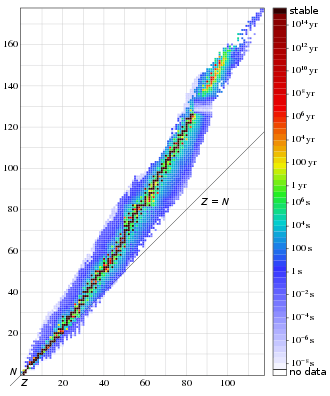Neutron number
The neutron number, symbol N, is the number of neutrons in a nuclide.

Atomic number (proton number) plus neutron number equals mass number: Z + N = A. The difference between the neutron number and the atomic number is known as the neutron excess: D = N - Z = A - 2Z.
Neutron number is rarely written explicitly in nuclide symbol notation, but appears as a subscript to the right of the element symbol. In order of increasing explicitness and decreasing frequency of usage:
| Element | C |
| Isotope/Nuclide | 14 C |
| With atomic number | 14 6C |
| With neutron number | 14 6C 8 |
Nuclides that have the same neutron number but different proton numbers are called isotones. This word was formed by replacing the p in isotope with n for neutron. Nuclides that have the same mass number are called isobars. Nuclides that have the same neutron excess are called isodiaphers.[1]
Chemical properties are primarily determined by proton number, which determines which chemical element the nuclide is a member of; neutron number has only a slight influence.
Neutron number is primarily of interest for nuclear properties. For example, actinides with odd neutron number are usually fissile (fissionable with slow neutrons) while actinides with even neutron number are usually not fissile (but are fissionable with fast neutrons).
Only 58 stable nuclides have an odd neutron number, compared to 194 with an even neutron number. No odd-neutron-number isotope is the most naturally abundant isotope in its element, except for beryllium-9 (which is the only stable beryllium isotope), nitrogen-14, and platinum-195.
No stable nuclides have neutron number 19, 21, 35, 39, 45, 61, 89, 115, 123, and ≥ 127. There are 6 stable nuclides and one radioactive primordial nuclide with neutron number 82 (82 is the neutron number with the most stable nuclides, since it is a magic number): barium-138, lanthanum-139, cerium-140, praseodymium-141, neodymium-142, and samarium-144, as well as the radioactive primordial nuclide xenon-136. Except 20, 50 and 82 (all these three numbers are magic numbers), all other neutron numbers have at most 4 stable isotopes (in the case of 20, there are 5 stable isotopes 36S, 37Cl, 38Ar, 39K, and 40Ca, and in the case for 50, there are 5 stable nuclides: 86Kr, 88Sr, 89Y, 90Zr, and 92Mo, and 1 radioactive primordial nuclide, 87Rb). Most odd neutron numbers have at most one stable isotope (exceptions are 1 (2H and 3He), 5 (9Be and 10B), 7 (13C and 14N), 55 (97Mo and 99Ru) and 107 (179Hf and 180mTa). However, some even neutron numbers also have only one stable isotope; these numbers are 2 (4He), 4 (7Li), 84 (142Ce), 86 (146Nd) and 126 (208Pb).[2]
Only two stable nuclides have fewer neutrons than protons: hydrogen-1 and helium-3. Hydrogen-1 has the smallest neutron number, 0.
References
- Teh Fu Yen, Chemistry for Engineers (Imperial College Press, 2008), p.265
- Audi, G.; Kondev, F. G.; Wang, M.; Huang, W. J.; Naimi, S. (2017). "The NUBASE2016 evaluation of nuclear properties" (PDF). Chinese Physics C. 41 (3): 030001. Bibcode:2017ChPhC..41c0001A. doi:10.1088/1674-1137/41/3/030001.